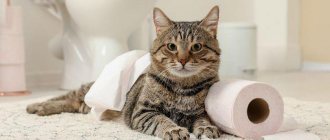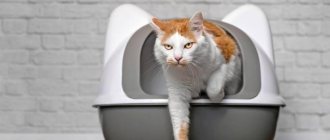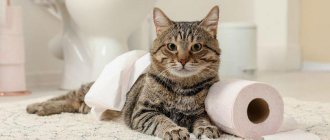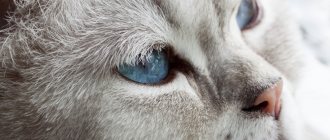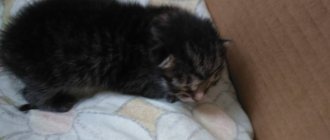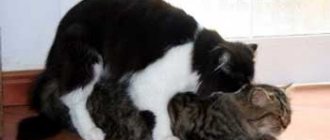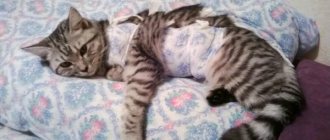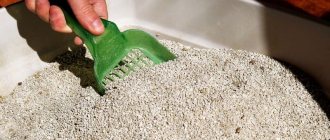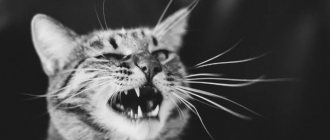What will you learn from the article?
- What can you do urgently before visiting a veterinarian?
- Urgent medical care
- Diseases that cause prolonged urinary retention
- The cat cannot go to the toilet - alarming symptoms
- Treatment options
- Special diet
- Prevention of diseases associated with difficulty urinating
A healthy adult cat's bladder should empty itself at least once a day. In some cases: moving, changing food, low activity of the animal, urination may be delayed for up to two days. If a cat cannot pee for more than two days or screams when trying to relieve itself, it must be urgently shown to a veterinarian.
What can you do urgently before visiting a veterinarian?
If it is not possible to quickly deliver the animal to a veterinarian, first aid should be provided by the cat's owners at home.
First aid is as follows: a warm compress or heating pad is placed on the stomach and perineal area. The heating pad and compress should be warm, but not hot! You can place the animal in a bath of warm water, making sure that the water does not reach the heart area.
It is forbidden to massage the cat's belly - this can cause serious complications.
Make sure that the cat drinks enough, and if he refuses to drink, force the animal to drink clean water from a pipette. Add some chicken broth to your regular food to increase your fluid intake. Play with your pet a little - this activates the work of all body systems. You need to play carefully so that the animal does not become overtired.
How to flush a Foley catheter at home
You can use a weak solution of potassium permanganate (1:10000), “Dioxidin”, which is diluted with water 1:40 or “Furacillin” (1 tablet 0.1 g per 100 ml of liquid). It is possible to rinse the catheter with Miramistin, a ready-made pharmaceutical solution, or a product recommended by the doctor. The rinsing is carried out in such a way that the patient does not experience pain or discomfort.
It is important to wash your hands thoroughly and use a sterile syringe with which the solution is delivered. The urinal is disconnected from the tube, and the end is treated with antibacterial solutions. Then attach a syringe, which slowly delivers the rinsing solution. You need to first apply about 20-30 ml, after introducing the liquid into the bladder, the syringe is disconnected. It flows back on its own. The rinsing is repeated three times, then the urinal is reattached.
Urgent medical care
First aid in a veterinary clinic involves inserting a catheter. Only a professional should insert a catheter, after first flushing the bladder with antiseptics. This operation is painful, so it is performed under general anesthesia. After catheterization, the veterinarian performs a series of tests to find the cause of urinary retention.
Important: you should not insert a catheter often - after this procedure, swelling of the urinary tract occurs. If the doctor sewed in a catheter for several days, you need to keep the cat in a special collar during this time so that it does not injure itself and does not remove the catheter.
Norms of urination in cats and cats
The number of urinations per day in adult cats and female cats may vary slightly. This is due to the difference in the structure of the genitourinary organs of males and females. Due to the longer and narrower urethra, cats need to pee 3 to 5 times a day.
While cats need 2-3 times a day. This multiplicity does not depend on previous sterilization or castration, so any deviations from the norm should be perceived by the owner as an alarming signal.
Diseases that cause prolonged urinary retention
If a cat cannot pee for more than two days, this may be symptoms of the following diseases:
- Cystitis is an inflammation of the mucous membrane of the bladder. The disease occurs due to infection entering the bladder or due to mechanical damage to the mucous membrane. Animals of all breeds and ages are prone to cystitis. Due to their anatomical features, cats get sick more often than cats. The presence of the disease is indicated by the fact that the cat does not go to the toilet very well - after the cat attempts to empty the bladder, small drops of urine are released. It hurts the cat to urinate, he screams heart-rendingly, rubbing against the walls of the tray. Over time, fear of pain makes the cat completely refuse to visit the litter box. In such cases, you should not postpone a visit to the veterinarian.
- Urethritis is an inflammation of the mucous membrane of the urethra. The disease usually develops against the background of cystitis. Neutered cats are most often susceptible to urethritis. If a castrated cat cannot pee, and after prolonged pushing, only droplets of urine appear in the tray, in which blood can be seen, then the animal urgently needs to be shown to a doctor.
- Urolithiasis (urolithiasis) is a pathology in which sand crystals and urinary stones form in the urinary tract and in the bladder itself. Sand and stones pass through the ureter, irritate and injure the mucous membrane, causing inflammation - the cat cannot go to the toilet without pain, and blood appears in the urine. In severe cases, the patency of the urinary tract is completely disrupted. Urolithiasis is a disease that requires urgent treatment. Only urgent surgery can solve the problem and save the pet’s life.
- Kidney diseases. The list of congenital and acquired diseases of this organ is long - cats are prone to kidney disease. Poor kidney function leads to irregular urination. A veterinary specialist should carry out diagnostics and determine a treatment regimen based on the test results.
- Dysfunction of the sphincter and bladder walls. The disease develops in older cats as a result of disruption of the central nervous system. Usually manifests itself as incontinence - old cats urinate on themselves. In some cases, poor urine output develops. The diagnosis can be made by a veterinarian.
- Urethral and bladder polyps are benign growths that resemble warts. They can block the urinary tract and interfere with the flow of urine. For diagnosis, it is necessary to conduct a number of studies (X-ray, ultrasound). The disease is treated surgically.
- Traumatic injury to the urinary tract. It is urgent to take your cat to the veterinarian if he has fallen from a height or been in a car accident.
- Congenital pathologies. Urinary retention may be associated with the development of the cat’s internal organs. In such cases, problems with urination appear at a fairly early age. Their timely and accurate identification is necessary.
Why might an animal have no urge to defecate?
In general, the reason is the same. Anesthesia. Due to general anesthesia, intestinal motility is disrupted and becomes much weaker. Accordingly, feces are not released. It is for this reason that 12 hours before surgery it is necessary to put the animal on a starvation diet. Neglecting this rule leads to very unpleasant consequences.
Firstly, during the operation, your pet may simply choke on vomit. This is again due to a violation of intestinal peristaltic activity. But this is not the worst thing. Even if the operation is successful, the digestion of food located in the gastrointestinal tract at that time will practically stop. It will simply begin to rot. Severe intoxication will occur, aggravated by the weakness of the cat after anesthesia. In such cases, the animal vomits, and when pressure is applied to the abdominal cavity, a pronounced pain reaction occurs.
A cat, even in a semi-conscious state, can literally roar or meow hoarsely in pain. Sometimes it is possible to save an animal only after a complex abdominal operation and removal of dead parts of the intestine. This will not improve your pet’s health, so listen carefully to everything the veterinary specialist tells you during the period of preparation for the procedure.
But still, more often than not , constipation in a cat after castration is a completely normal phenomenon , and only those owners who, contrary to the veterinarian’s instructions, fed their pet heavily before the operation, should panic. In other cases, you need to be patient and normalize your diet.
But still, in cases where your cat has not defecated within three days after castration, it is strongly recommended to use laxatives. There is no need to give your animal products from your home medicine cabinet yourself. If you overdose, you can cause prolonged diarrhea in your pet. In addition, many drugs from “human” pharmacies are created with human biochemistry in mind, and therefore they are poisonous to animals.
The cat cannot go to the toilet - alarming symptoms
Untimely outflow of urine can provoke life-threatening conditions for the cat. In stagnant urine, pathogenic bacteria multiply rapidly. The bladder may not be able to withstand the strain. General intoxication of the body is no less dangerous for the health and life of the pet.
Therefore, it is so important to learn how to identify the first symptoms of painful and difficult urination. The following signs of trouble should alert the owner:
- the cat sits in the tray for a long time, spins around, chooses a pose, but in the end the tray is dry;
- the animal screams while trying to urinate;
- cats constantly lick the urethral area and meow pitifully;
- traces of blood, pus, and white flakes are visible in the urine;
- a sudden change in the color or odor of urine;
- urination disorders are accompanied by fever, lethargy, drowsiness, refusal to drink or severe thirst;
- the animal refuses to play, becomes aggressive, restless;
- the abdominal wall becomes painful and tense;
- cats meow and scratch when you try to pick them up.
If one or more symptoms appear, it is necessary to show the animal to a specialist for diagnosis and treatment.
Treatment options
The article is based on the expert opinion of the head physician of the veterinary clinic Averiya Telnova I.Yu.
A little higher, we looked at ways to help a cat go to the toilet to pee - we were talking exclusively about first aid. Self-medicating in such cases means putting your pet’s life in danger.
The decision on the choice of treatment method must be made by a veterinarian. In some cases, only urgent surgery can save a cat’s life, so it is so important not to delay a visit to the doctor.
The treatment regimen is prescribed by a veterinarian taking into account the medical history and final diagnosis.
Depending on the nature of the disease, antibacterial, anti-inflammatory, antiviral, diuretic, painkillers, antihistamines and hormonal drugs are prescribed.
All that is required of the owner is to strictly follow all medical instructions, provide the animal with comfortable living conditions, maintain a drinking regime and adhere to the diet recommended by the doctor.
Showering with a catheter and urine bag
It is important to maintain good body hygiene by showering regularly. This reduces the risk of infection. Before standing under the stream of water, the urinal is disconnected and the catheter is clamped with a special clip. When washing, you should gently wash the genitals around the catheter using baby or liquid soap with a neutral pH.
After bathing, the catheter tube is carefully dried, the genitals are blotted with a soft cotton towel, and a clean urine bag is put on. You can swim every day, following these rules.
Special diet
Regardless of the diagnosis, a sick cat will need a corrective diet. It is necessary to exclude from the animal’s diet foods that irritate the kidneys and organs of the urinary system.
Cheap dry food of the “economy” and “premium” classes is prohibited. These products contain a lot of salt, preservatives, flavors and dyes. Of the expensive dry food, only special brands designed for animals with urological diseases and urolithiasis are allowed.
Foods that should not be given to sick cats:
- Pork is a fatty meat that thickens urine.
- Milk is a source of magnesium, which obstructs the flow of urine.
- Salt.
- Raw fish contains phosphorus. May cause the formation of stones in the bladder.
- Raw meat. Protein foods overload the kidneys.
Until the animal’s condition stabilizes, the cat’s diet should be light, high-calorie and natural. It is imperative to ensure compliance with the drinking regime - the cat should always have a sufficient amount of fresh drinking water.
Diagnostics
Cats may experience partial or complete blockage of urine
and the signs of this pathological condition can vary greatly. If there is a partial blockage, the affected cat may appear stiff or in pain and tend to spend a lot of time going in and out of the litter box. The owner may notice unfortunate urination incidents around the house or find small puddles of urine (sometimes bloody) in the litter box or unusual places.
As the condition progresses to complete blockage and the cat is unable to push urine out, the signs become more intense and the cat may develop life-threatening complications. Urinary retention in a cat is characterized by nausea, loss of appetite and the animal becoming extremely lethargic. If left untreated, urinary retention can lead to kidney failure and death within 24 to 48 hours. Cases of bladder rupture are common. Subsequently, hydronephrosis may develop - an irreversible pathological change in the structure of the kidneys with difficulty in the outflow of urine from the renal pelvis.
If your cat exhibits any of these signs, contact your veterinarian or go to your nearest emergency animal hospital immediately.
Prevention of diseases associated with difficulty urinating
Problems with urination appear especially often in castrated, neutered, elderly, weakened animals and in obese cats.
Preventive measures should include:
- regular examination by a veterinarian and strict compliance with all instructions issued by the doctor;
- control of the animal's weight. Obesity causes a malfunction in many body systems, primarily the excretory system;
- compliance with a corrective diet;
- monitoring compliance with the drinking regime;
- preventing animal hypothermia;
- complete rejection of salt in cat food and other salty foods: smoked meats, sausage, salted meat and fish.
Attentive attitude towards your pet will allow loving owners to promptly identify and eliminate problems associated with urinary retention.


